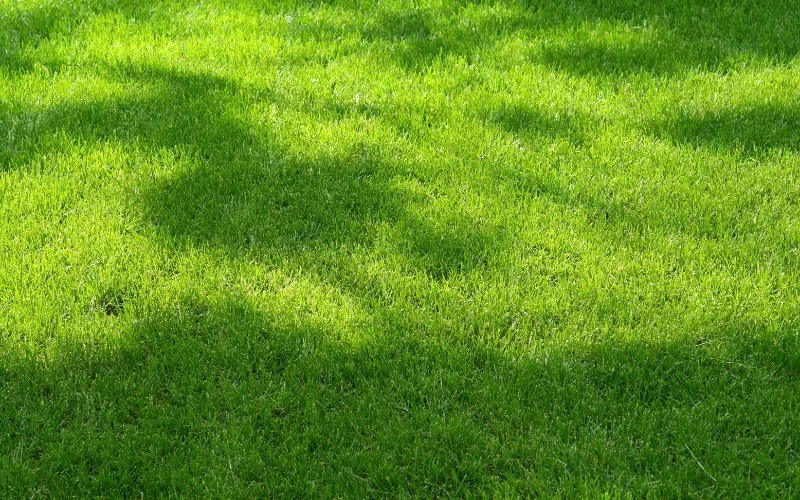Growing grass in the shade isn’t the same as growing grass in the sun. When it’s grown in the shade, grass has different nutrient and water requirements as well as different tolerances to mowing and traffic. Below you can learn what exactly these differences are, how you should handle grass that’s growing in the shade, and which grass types do the best when grown in shade.

How to Grow Grass in the Shade (The Short Answer)
To successfully grow grass in the shade you need to do 3 main things: know how much light you have, find a grass type that grows in the range, and improve drainage in the shaded area. If you do these 3 things, you will avoid most of the pitfalls and suffering associated with cultivating a lawn in the shade.
The Challenges of Growing Grass in a Shaded Area
The real challenge of how to get grass to grow in the shade is that most of what you’re doing for a sunny lawn is going to weaken and eventually kill off a shaded lawn. Shaded lawns need more care and, usually, that means remembering to give them less of one thing or another or simply giving your lawn more time. Below are the most common specific challenges of growing a lawn in a shady area.
Deep Shade Leads to High Moisture
The more shade you have, the more moisture is likely trapped in this area. To keep your lawn from being overwhelmed by this constant dampness, you will need to water it less and adjust your watering schedule whenever it rains. You may also need to work to improve the drainage or soil composition in this area if you want a dense, even lawn and have had a hard time achieving this in the past, even after choosing the right grass type and reducing added water.
Grass Seed Needs Light to Germinate
Grass seeds will not germinate in a successful or healthy way with no light. They can do so in low light conditions but the more shaded your lawn is, the longer it may take your grass seeds to germinate and establish themselves.
Sunlight Stimulates Grass Growth
When grass has more access to sunlight, it has more opportunities to produce the food and energy it needs to thrive. With limited access, your lawn may be slower to grow and repair itself after injury, such as mowing, or illness such as overwatering or fungal growth.
Sunlight is a Natural Disinfectant
Direct sunlight contains ultraviolet radiation. Though not powerful enough to decimate the bacteria and fungus, both helpful and destructive, living on and around your lawn it is strong enough to help keep these things at more manageable levels. In the dark, especially if the shady part of your lawn gets closer to 4 hours of filtered sunlight a day or less, diseases and infections can progress more quickly than they would in a sunnier patch of lawn.
Sunlight Helps Improve the Evaporation Rate and Lessens the Need for Other Types of Drainage
Exposure to consistent sunlight heats an area and helps aid evaporation. Without it, water remains for longer and can become stagnant if no other avenue for drainage exists.
Why Grass Type is Key When Dealing With Shade
As noted above, all grass types need some sun to germinate and grow. However, some grass types are more efficient with their use of sunlight than others. For example, grass with fine blades needs less energy to grow and spread while grass that spreads via rhizome has another avenue for food storage, if necessary.
Even within the best overall grass types for a shady lawn are specific, branded cultivars that are best adapted for shade. Below are the broad strokes of which grass type to look for, but you may wish to contact a local seed store or lawn care expert to see if they have something even better or an improved variety available locally.
The Best Grass Types For Different Levels of Shaded Lawns
Most grass types that are great for shaded areas happen to be common grass types naturally found in these areas. Further, as a shady lawn is less common, there may be fewer cultivars of these grass types available.
Partial Shade (About 6 Hours Dappled of Sunlight Per Day)
If you get about 6 hours of sun per day, give or take an hour, you have many options and, honestly, if you implement the tips found in the following section, almost any popular grass type will do.
The best grass type to have in any shady situation, if you can make use of cool-season grass, is fine fescue. Fine fescue needs as little as 3 hours of sun per day, requires little in the way of fertilizer and nutrients, and has a pleasant, soft texture and deep green appearance.
Perennial ryegrass is a close second and needs closer to the full six hours of sun a day but it’s easy to establish and has a similar appearance and texture.
If you need a warm-season grass, St. Augustine and centipede grass can both do well in low-light environments. Even Zoysia grass can handle 6 hours of sunlight, though it will be slower to establish than usual.
Full Shade (3 to 4 Hours of Dappled Sunlight Per Day)
For a lawn this shaded, your best bet is tall fescue or Kentucky bluegrass grass types if you can use cool-season grasses. If you have a shaded lawn and need a warm-season grass, your best option is St. Augustine, though this will need at least 4 hours of sunlight per day.
Deep Shade (2 Hours or Less of Weak Sunlight Per Day)
For anyone that wants to grow a lawn in deep shade, I have bad news. While you can coax fine fescue to work here with somewhat reliable coverage, your best bet would be to accept that your lawn will be overtaken with moss and low-light plants. That is unless you can improve the amount of light your lawn gets.
How to Grow Grass in the Shade Successfully (Things I Recommend You Do)
Even if you want to keep whatever grass type you have instead of choosing a grass type that may work best in your specific situation, I can give you some advice that may help that grass do better than it is now. However, there are limits to this advice, as noted with each suggestion.
Evaluate How Much Shade You Have
Before you do anything else, you need to know how much shade you have in a given area. Most people will estimate how much shade they think there is in a given area and vastly overestimate it. This is not a skippable step. Even if you know the shady part of your lawn doesn’t get much sun exposure, you want to know how much or how little as exactly as possible.
To do this, you need to go out every hour and look at this shady patch of lawn. Does it get any sunlight, even dappled sunlight? If so, that’s a point in favor of the sun. If there are no patches of sunlight whatsoever, that’s a point for full shade. At the end of the day, tally up how many hours the sunlight was able to reach this patch of lawn. These hours may not be consecutive.
Depending on what casts the shadow covering your lawn, you may get a few hours in the morning and a few in the evening.
Accept That The More Shade You Have, the More Likely You Will Need Companion Plants
“Companion plants” here means “plants that fill in the bare spots of your lawn, making it look fuller, without competing with your lawn.” The most common example is white clover. What you want to look for, if you choose to go this route, is a low-growing plant that can thrive in full shade and that spreads slowly.
Alternatively, Create a Little More Light for Your Shady Lawn
If the number of hours of sun isn’t enough for the type of grass you have or the variety of grass you want, you can try to increase it. If fences are causing the problem, you can replace them with different types or add windows to them. If trees are the problem, you can consult an arborist and have them trimmed to give your lawn and garden more light.
Evaluate Drainage and Improve As Needed
Good drainage is an often overlooked key to how to get grass to grow in the shade. Shady spots tend to collect water as it evaporates less from these zones. If the ground is perpetually muddy in the shady part of your lawn where the grass isn’t growing, figure out how to get it to drain. This could mean aeration, adding more sand or silt, or digging an underground channel.
Water Your Lawn Sparingly
Shady areas generally require less water than sunny areas. There is less evaporation happening, even in hot weather, and trees and other nearby structures can trap moisture, leading to oversaturation.
It’s important to water deeply and infrequently. Allow the soil to dry out slightly before watering again. This will encourage deep root growth, making the grass more drought-resistant.
Be Mindful of Your Soil Type
As the grass in shady areas will use less water and is more likely to experience soil compaction in high-traffic areas, knowing your soil type can help you avoid these issues. For example, shady areas that also have high clay soils can become waterlogged quickly. Shady areas with sandy soil are less likely to hold onto excess water but may hold excess nutrients and break down fertilizer more slowly instead.
Select and Plant the Right Grass Type for Your Level of Shade
Above you can find a selection of different grass type recommendations based on the light level. In short, however, fine fescue is the best overall and cool-season grass type for low-light and shady lawns. For warm-season grasses, St. Augustine is a good choice, though it needs at least 6 hours of decent sunlight per day to fill in well.
Fertilize Your Shade-Tolerant Grass Carefully
Over-fertilization is a real risk to grass in lower light levels. Due to the slowed growth and energy production rates as well as less frequent mowing, grass in shady areas will be able to use less fertilizer than grass in direct sun. Because of this, I would recommend only fertilizing the lawn in shady areas once a year and always with a slow-release fertilizer or compost.
Let Your Grass Grow Up a Little Longer Before Mowing
Keep your grass a little longer than usual. For most grass types, this means keeping your grass at 3 inches or a little higher. This increases its surface area for photosynthesis, helps with moisture distribution, and lowers the chance that other plants or organisms will shade out or grow over your grass.
Keep Traffic Light
Grass grown in the shade is generally more delicate than grass types that get a lot of sunlight. This is true even if you’re using the best grass types for shade, like fine fescue or perennial ryegrass. Reducing traffic or pressure on your lawn can help prevent soil compaction, drainage issues, or unnecessary stress for your lawn.


Leave a Reply